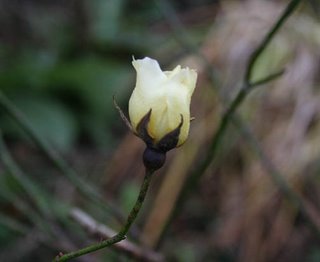It’s hard to make judgment calls about weather systems overall when there are such a variety of microclimates, even in one part of one province. In summer, the Annapolis Valley may be shimmering with heat, but come up over the mountain to the Fundy shore, and you may find yourself wrapped in fog, with at least 15 degrees (Fahrenheit) difference in temperature.
In fall and winter, we’re often subject to that curious phenomenon of flurries where winds blow on shore—and those flurries can accumulate to serious inches of snow. So when I looked out the window this afternoon and saw the flurries, I grabbed my camera and took a picture of a typically bleak Fundy day in the NO month of November.

Then something caught my eye in the garden, something I hadn’t noticed when I was doing a bit of much-needed cleanup the other day. I pulled on a sweater and boots and traipsed out to have a look.

Yup, your eyes do NOT deceive you. This, dear friends and gentle gardeners, is the bud of a Golden Wings rose. There are actually two of them on the same branch, shimmering bright against the dying of the light, and the coldness of the Norwest wind coming in off the Bay.
They gave me hope, as blooms always do, that we’ll yet have a few nice days. In fact, Friday was a decent day, when the skies were blue and the light golden and the play of light on larch and pine made me intensely happy, if only for a few hours (while the sun was out.) And looking at this photo again, my heart with pleasure fills, just like William Wordsworth. True, there are no daffodils to dance through at this time, but still and all…there is beauty around us to lift the heart.

One of my favourite autumn sights is looking down from the Wellington dyke towards Blomidon, across cornfields, apple orchards, the dykelands around the mudflats, with the brooding edge of Cape Blomidon in the background. I’m always struck with wonder whenever I look at the dykelands that hold back the Minas Basin from flooding huge sections of the Annapolis Valley. The sense of history catches me, every time, as the dykes and aboiteaux were initially built and maintained by the Acadians who farmed and developed this land beginning 400 years ago with the establishment of Port Royal further down the valley and the Bay. The dykes and aboiteaux, or sluiceways, that work on the tidal rivers are maintained today by different methods and with different materials, but still they hold back the waters, claiming thousands of acres of arable farmland that would otherwise be underwater.
And I hear, too, the whispers of ghosts, the ghosts of Acadian settlers long gone, expulsed from this their homeland and scattered in their own Diaspora. And though I’m not Acadian, I pause to give respect to those first settlers, farmers, woodsmen, craftswomen, families…always remembering them, in sun or in snow.



No comments:
Post a Comment
Thank you for visiting and for taking the time to comment! It might take me a bit, but I will return the compliment whenever possible.
Spammers--need not apply. Because I delete your comments and they will never make it here. Kthxbai!